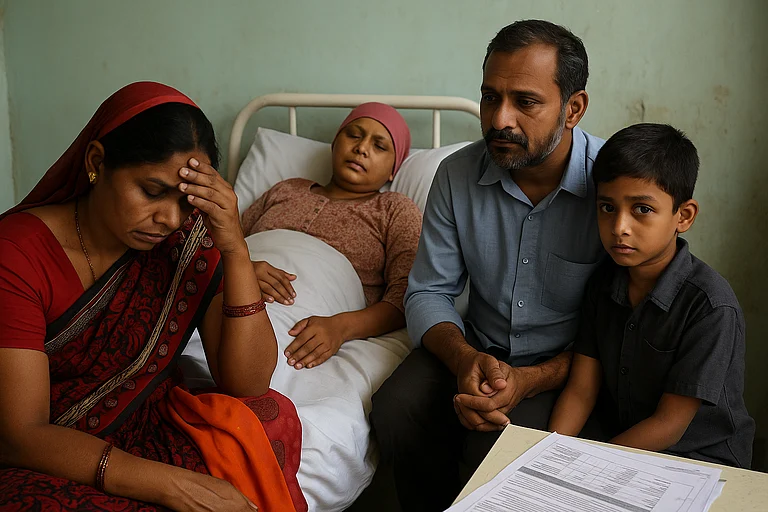Oral and breast cancer cases rising nationwide.
Lifestyle and tobacco use driving higher cancer burden.
Eminent haematologist stresses prevention, screening and better diagnostics.
India Facing Alarming Rise In Oral, Breast Cancer Cases, Warns Haematologist Mammen Chandy
India is facing a steady rise in oral and breast cancers. eminent haematologist Chandy links it to lifestyle risks, urging stronger prevention, diagnostics, and research
India is facing a steady rise in cancer cases, particularly oral and breast cancers, driven by lifestyle changes, tobacco use, delayed diagnosis, and environmental factors, eminent haematologist and Padma Shri awardee Dr Mammen Chandy said.
Chandy said these trends pose a major public health challenge for the country.
“Between 1990 and 2021, oral cancer mortality in India increased from 5.32 to 5.92 per 100,000, and the disability-adjusted life-year rate rose from 152.94 to 163.61,” he told PTI in an interview.
The disability-adjusted life-year (DALY) rate is a measure of the overall burden of a disease in a population, expressed as a rate per 100,000 people.
Chandy said the age-standardised prevalence rate (ASPR) also jumped from 15.71 to 25.46 during the period, reflecting a significant annual increase.
Age-standardised prevalence rate is a statistical measure that allows for the comparison of disease or health rates between populations with different age structures.
“Forecasts indicate an upward trend in oral cancer metrics from 2022 to 2031, with ASIR (age-standardised incidence rate) expected to reach 10.15 per 100,000 and mortality rate (ASPR) 29.38 per 100,000 by 2031,” Chandy said.
Men consistently exhibit higher rates than women, and the burden varies significantly across states, said the former director of Tata Medical Centre, Kolkata.
Cases of breast cancer have also seen a sharp rise.
“Globally, breast cancer is now the most common malignancy among women, surpassing lung cancer. In India, the ASIR in females has increased by nearly 40 per cent from 1990 to 2016, with every state reporting an uptick,” Chandy said.
He said that lifestyle factors, obesity, alcohol consumption, delayed childbirth, and better access to diagnostics are contributing to the rise.
“Tobacco, alcohol, and smoking are the primary risk factors for oral cancer, while breast cancer reflects a combination of genetic, lifestyle and diagnostic factors,” he said.
Chandy also welcomed the Union government’s decision to establish cancer care centres in all districts.
“This is a step in the right direction. India currently follows two complementary models: the private sector, where patients are referred to multi-specialty or tertiary hospitals, and the public sector, where patients are seen at primary health centres and referred to state cancer hospitals. Public funding is critical, but the focus must be on improving quality of care,” he said.
On research and genomics, Chandy highlighted the Bharat Cancer Genome Atlas (BCGA), launched by IIT-Madras.
“This pioneering initiative maps the genetic landscape of cancers prevalent in India. While primarily a data-collection exercise at present, it allows researchers to study genetic changes and develop targeted therapies,” the eminent doctor said.
Commenting on recent experimental drug trials, he noted the promise of ‘Dostarlimab-gxly (Jemperli)’, a PD-1 inhibitor, which achieved a 100 per cent complete response in a small group of colorectal cancer patients with mismatched repair-deficient tumours.
“This is remarkable, but it applies to only 4-5 per cent of patients. The rest still require conventional treatments like surgery and chemotherapy,” he said.
‘Dostarlimab-gxly (Jemperli)’ is a type of immunotherapy drug that blocks the PD-1 protein on T-cells to help them attack cancer cells.
On Russia’s announcement of a personalised mRNA cancer vaccine, he said, “While promising in theory, there is no published clinical data yet. mRNA vaccines worked for COVID, but cancer is more complex, and efficacy must be proven.” The Padma Shri awardee also expressed cautious optimism about precision medicine and modern diagnostics.
“For certain cancers, such as childhood acute lymphatic leukemia and Hodgkin’s lymphoma, modern therapy guided by molecular diagnosis can cure up to 90 per cent of patients. Better diagnostics allow targeted treatment with fewer side effects, but a future free of cancer is unlikely,” he said.
India’s rising cancer burden reflects broader public health challenges, Chandy noted.
“We have more than a million new cases every year. Breast, cervix and ovarian cancers are the most common among women, while lung, oral and prostate cancers dominate among men. Alarmingly, cancers are affecting younger patients than in Western countries. The median age for lung cancer in India is 59, compared to 70 in the US and 75 in the UK,” said Chandy, considered the father of bone marrow transplant.
The high incidence stems from tobacco use, pollution, obesity, poor diet and sedentary lifestyles.
“Almost 40 per cent of cancer cases in India are linked to tobacco, and environmental and lifestyle factors contribute to many others,” he said.
Despite these challenges, Chandy, however, said there is reason for hope.
“We now have more cancer centres offering state-of-the-art diagnostics and treatment, and domestically produced drugs are more affordable. But India must invest in prevention, screening and research to truly manage the burden,” he said.
“Screening rates for oral, breast and cervical cancer are below one per cent nationally. Expanding access to early detection is critical if we want to curb cancer-related mortality,” Chandy added, highlighting the importance of coordinated efforts across government, healthcare systems and society.
